
5月でも、長野の山の頂に雪が残っています。森は目覚めたばかりです。
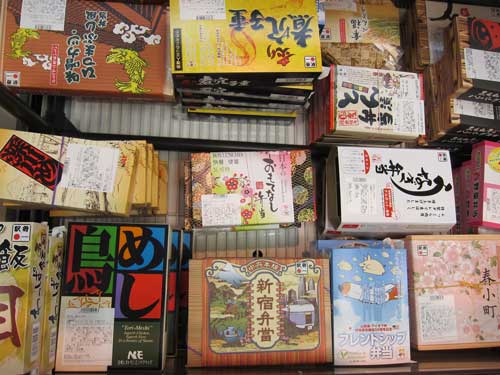
Last weekend I went to Suwa in Nagano with Kobayashi sensei of Sinajina for the famous, once every six years onbashira festival.
Over two months, the residents of Suwa select enormous trees growing on top of the mountain ridge, cut them and transport them down the hills by dragging them with rope, race down a hill sitting on the logs, and eventually lift them up at several important shrines (while people stand on top of them, I guess, to make it more difficult, heavy and dangerous).
Onbashira is a very pleasant mix of animism, forestry and virility. More on the ceremony later.
But, first, the first joy of taking any trip in Japan is buying a bento at the station. There is an incredible variety, priced from about 500 yen to 1,500 yen. Each comes beautifully wrapped in a box, with fantastic graphic design. You can see some cool typography, artistic mountains and trains, a space shuttle, a pokemon, and cherry blossoms.
I chose the spring special, decorated with sakura petals. Inside I was delighted to find over twenty different foods, including takenoko (bamboo shoots).

Even more remarkable, my box came with a photo and description of the organic rice farmers.
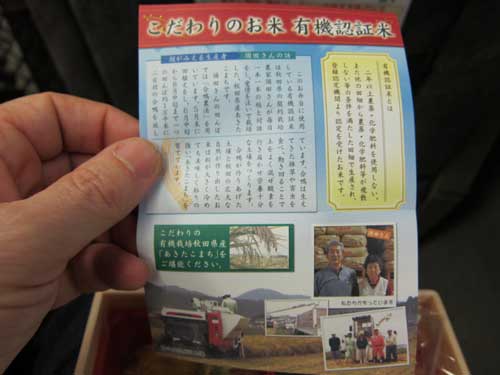
And lastly here’s the purple-striped beauty that got us to the Suwa lake in just two hours from Shinjuku.

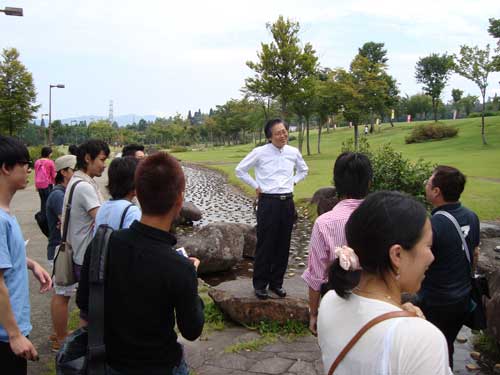
Frankly, arriving at New Greenpia (ニュー・グリーンピア) was a landscape and cultural shock after Obuse. Compared to the 600 year history of Obuse and multi-layered reinventions from the 1990s to the present, New Greenpia’s buildings and gardens reflect Japan’s famous Bubble from the 1980s. Amazingly, many of the Nodai students were born at the very end of the 1980s.
If I understood it correctly, it was a semi-public resort created to provide a place for working class urban people to experience nature. Sometime in the past five years, financial ruin led it to be sold to private owners, at a scandalously low price.
Next to a giant building that serves as conference center, hotel and event space, there are huge lawns leading to tennis courts and golfing. Between the building and the recreation area is a narrow river-themed landscape created by a Nodai professor over 20 years ago. The original design has water coming out of concrete cones, which is no longer functioning.
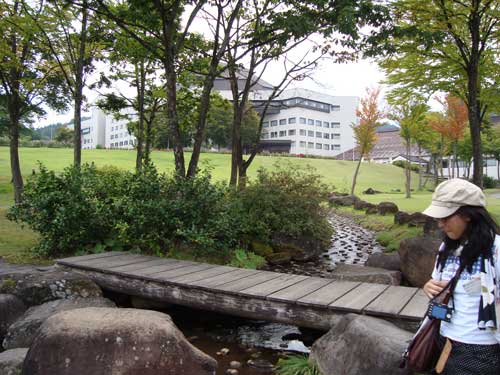
I realize that the built environment was created with good intentions. Still, the scale of the building and the large empty lawns do not take advantage of the natural surrounds. The garden river, too, seems a poor imitation of the surrounding abundance of natural streams and irrigated fields. And the lack of maintenance is a glaring testimony of the financial troubles Japan has encountered in the past 20 years. If anything, New Greenpia served as an educational transition between the seeming success of Obuse and the haunting abandonment we witnessed in Echigo, Niigata, the site of the Niigata Art Triennial, the subject of my next post.
Perhaps New Greenpia sees more activity during ski season. We saw a few go-carts racing down the snow-less slope. I will end this post with an unsettling image near the entrance to the building promoting weddings in sunflower fields (of which we saw no evidence). Maybe the giant photo ad is meant to suggest the contemporary relevance of nature for young yankii couples, possibly city residents. I wonder why all the guests are dressed in black.
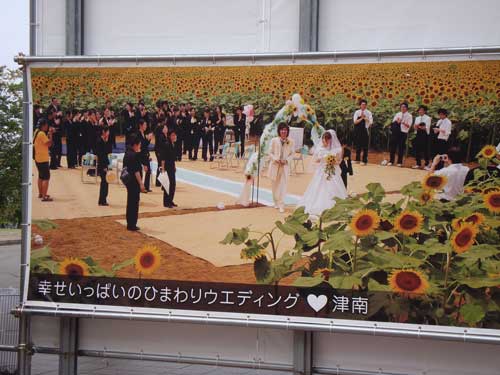
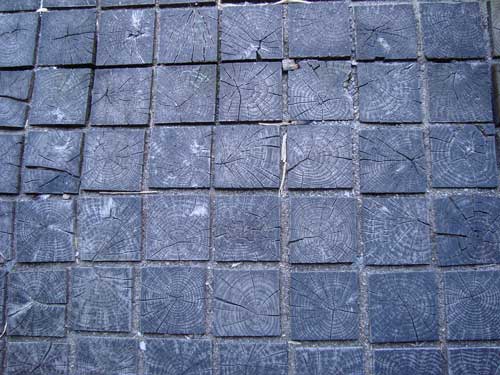
Obuse, as I mentioned in the previous post, is a revitalized small town that was once a center of commerce and culture. Revitalization centers on tourism and agricultural production, with a restored city center that is very charming. Above are wood sidewalk pavers made from chestnut trees: unique and tied to the town’s 600 year history, in which chestnuts were one of the few agricultural products that could grow in the silty river valley.
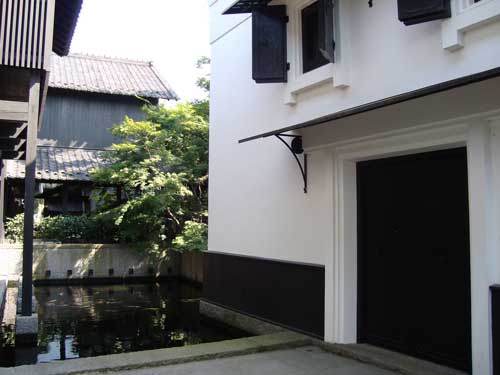
It was also wonderful to see the old sake distillery buildings reworked into a chic restaurant and high end hotel. It is rare in Tokyo to see creative re-use of old buildings. The restaurant where we ate featured chestnuts with rice, and displayed an enormous wood sake barrel and old photographs in the bathroom. I like how preservation and stylishness are combined here.
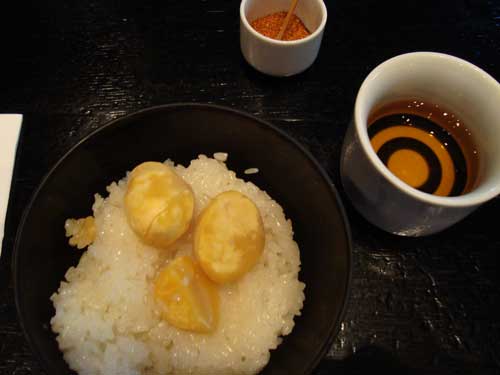
The Obusedo Honten Restaurant serves seasonal food and aims to be a “vegetable showroom” with a “from the countryside to the kingdom concept.” The restaurant was able to accommodate all 55 of us, and it was chic and tasty.
In addition to the obligatory “omeyage” store where you can buy chestnut sweets to bring back from your trip, there is also a revitalized Masuichi-Ichimura Sake Brewery that uses old techniques like wood barrels for distilling and ceramic bottles for sale. Again, they do a terrific job of making Japanese rural traditions modern and appealing.
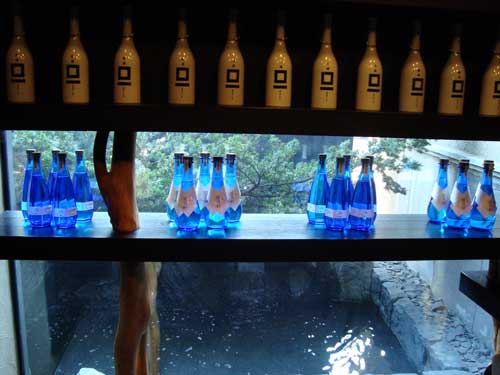
One of the driving forces behind Obuse’s revitalization is an American woman named Sara Marie Cummings, who settled in the town more than 15 years ago. In a country that is often resistant to foreigners, it is great to see how an American has helped this town find its future by reviving its past and appealing to modern sensibilities. She gave a brief talk to the students and professors.
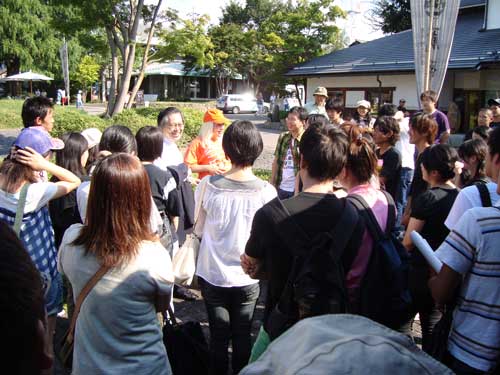
Cummings has created a cultural salon and a marathon to engage locals and bring in visitors. In collecting information about the town, the students and I discovered that there is also an “Open Garden” program where residents and small businesses create gardens open to the streets and sidewalks. A plaque shows their participation, and provides an English-only welcome.
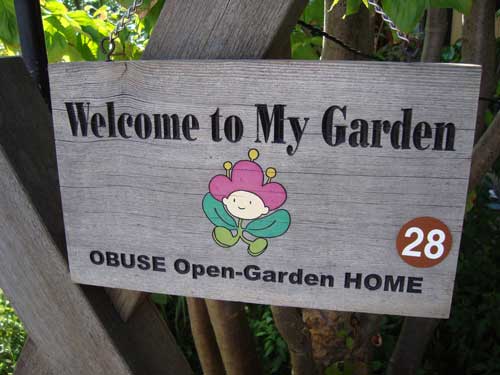
See some more photos after the jump:
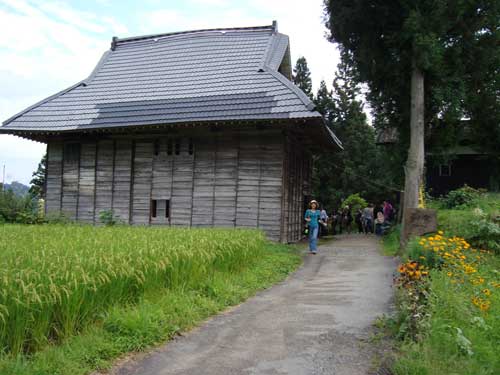
Last week I visited Nagano and Niigata prefectures with Nodai. It was my first experience seeing the incredible beauty of the countryside, the rice fields and satoyama ecosystems, steep hills, wood houses, and small towns. The focus of the trip was rural revitalization and experiencing history, both centuries-old and more recent, in landscape.
Although I had heard of satoyama from 5bai Midori, I had not expected to be so overwhelmed by the exuberant greenery of rice field, abundant water and forest. In some ways, the agricultural landscape looks like it had been there for 2,000 years of co-habitation between people and nature. Because of the small plots and terraces, much of the farming is still done by hand, and there was no evidence of industrial agri-business like flat Kansas wheat fields or Maryland chicken mega-factories.
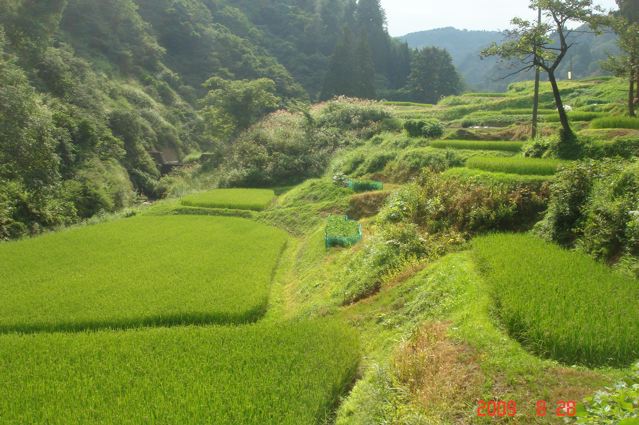
Our university field trip made clear that this is no pastoral eden. Abandoned houses and schools reflect a rapidly aging and shrinking population, and we witnessed buildings from Japan’s 1980s Bubble that were shuttered or on the verge of bankruptcy.
The trip included three major locations connected to efforts by Nodai’s professors in the Garden Design Laboratory and Landscape Architecture Science. The tour was led by Professors Shinji, Suzuki and Hattori.
1. Obuse in Nagano: an Edo town that was once a center of commerce and culture due to its location at the confluence of the Matsu-kawa River and Chikuma River, with a six hundred year history of chestnut trees and one hundred year old sake distillery. Today there is a famous Hokusai Museum, restaurants, chestnut foods, sake production, a marathon, and an “open garden” town program.
2. New Greenpia (ニュー・グリーンピア), a massive resort built in the 1980s to provide outdoor experiences for working class urban residents. A central feature is a garden designed by a Nodai professor, and the resort history shows how the exuberance of the Bubble laid a poor foundation for the past two decades. Its name refers to its green mission and its uto*pia*n ambitions.
3. Echigo Tsumari Art Triennial, which describes itself as “350 artworks, deployed in communities, rice fields, vacant houses and closed schools, are the fruit born from the collaboration and exchanges between rural locality and city, artist and satoyama, and young and old.” A Niigata Art Triennial director spoke with our group outside Marina Abramovic’s Dream House (see Nodai Trip, part 4, for more on this installation and Niigata Art Triennial).
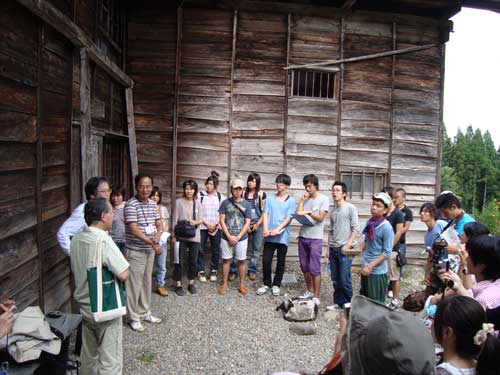
The trip also included a chance to speak informally with the professors, graduate and undergraduate students, and Research Fellow, plus banquets with enormous portions, visits to Japan’s giant highway rest stops, and onsen bathing.
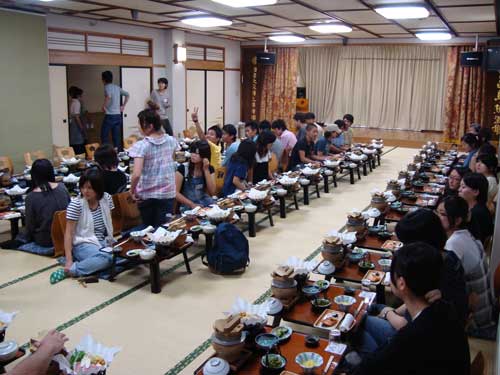
And lastly, there was an informal lesson on making onigiri for my foreign colleague and me.
I’ll post more photos and observations from the trip in the next days.